Comparing Quality Control Procedures Based on Minimum Covariance Determinant and One-Class Support Vector Machine Methods of Aircraft Meteorological Data Relay Data Assimilation in a Binary Typhoon Forecasting Case
Abstract
:1. Introduction
2. Overview of the Binary Typhoons
3. Data, Methodology, and Experiments
3.1. AMDAR Observations and Other Datasets
3.1.1. AMDAR Observations
3.1.2. Reference Data
3.2. Introduction of the Two Quality Control Schemes
3.2.1. MCD
3.2.2. One Class SVM
3.3. Numerical Model and Data Assimilation System
3.4. Experimental Design
4. Results
4.1. Quality Change in AMDAR Data
4.2. Analysis Results with AMDAR Data Assimilation
4.3. Forecasting Results
4.3.1. Precipitation Forecasts
4.3.2. Track and Intensity Predictions
5. Conclusions and Discussion
Author Contributions
Funding
Institutional Review Board Statement
Informed Consent Statement
Data Availability Statement
Acknowledgments
Conflicts of Interest
References
- Petersen, R.A.; Cronce, L.; Mamrosh, R.; Baker, R.; Pauley, P. On the Impact and Future Benefits of AMDAR Observations in Operational Forecasting: Part II: Water Vapor Observations. Bull. Am. Meteorol. Soc. 2016, 97, 2117–2133. [Google Scholar] [CrossRef]
- WMO. Aircraft Meteorological Data Relay (AMDAR) Reference Manual; Secretariat of the World Meteorological Organization: Geneva, Switzerland, 2003; ISBN 978-92-63-10958-3. [Google Scholar]
- WMO. Guide to Aircraft-Based Observations (WMO-No. 1200), 2017th ed.; WMO: Geneva, Switzerland, 2017; ISBN 978-92-63-11200-2. [Google Scholar]
- Ballish, B.A.; Kumar, V.K. Systematic Differences in Aircraft and Radiosonde Temperatures: Implications for NWP and Climate Studies. Bull. Am. Meteorol. Soc. 2008, 89, 1689–1708. [Google Scholar] [CrossRef]
- Cardinali, C.; Isaksen, L.; Andersson, E. Use and Impact of Automated Aircraft Data in a Global 4DVAR Data Assimilation System. Mon. Weather Rev. 2003, 131, 1865–1877. [Google Scholar] [CrossRef]
- Petersen, R.A. On the Impact and Benefits of AMDAR Observations in Operational Forecasting—Part I: A Review of the Impact of Automated Aircraft Wind and Temperature Reports. Bull. Am. Meteorol. Soc. 2016, 97, 585–602. [Google Scholar] [CrossRef]
- Zhong, J.Q.; Chen, M.; Fan, S.Y. Assimilation Application of AMDAR Data to the Operational NWP System of Beijing. J. Appl. Meteorol. Sci. 2010, 21, 19–28. [Google Scholar]
- Petersen, R.A.; Cronce, L.; Mamrosh, R.; Baker, R. Impact and Benefits of AMDAR Temperature, Wind, and Moisture Observations in Operational Weather Forecasting; WMO: Geneva, Switzerland, 2015; p. 93. [Google Scholar]
- Hoover, B.T.; Velden, C.S.; Langland, R.H. Adjoint-Based Analysis of Observational Impact on Tropical Cyclone Forecasts. In Proceedings of the 31st Conference on Hurricanes and Tropical Meteorology, San Diego, CA, USA, 31 March–4 April 2014. [Google Scholar]
- Rui-wen, W.; Wei, H.; Wei-hong, T.; Jian-dong, G. Blacklist Design of AMDAR Temperature Data and Their Application in the CMA-GFS. JTM 2021, 27, 368–377. [Google Scholar] [CrossRef]
- Chunyan, S.; Shijun, L.; Sudan, F. Effect Study of Different AMDAR Data Assimilation Time Window to Typhoon Yagi. J. Mar. Meteorol. 2021, 41, 11–25. [Google Scholar]
- Liao, J.; Wang, H.; Zhou, Z.; Liu, Z.; Jiang, L.; Yuan, F. Integration, Quality Assurance, and Usage of Global Aircraft Observations in CRA. J. Meteorol. Res. 2021, 35, 1–16. [Google Scholar] [CrossRef]
- United States National Weather Service Systems Development Office Technique Specification Package 88-21-R2 for Awips-90 Rfp Appendix G Requirements Numbers 2. 1 Quality Control Incoming Data; U.S. Dept. of Commerce National Oceanic and Atmospheric Administration National Weather Service Office of Systems Development: Washington, DC, USA, 1994.
- Sako, H. Assimilation of Aircraft Temperature Data in the JMA Global 4D-Var Data Assimilation System. CAS/JSC WGNE Res. Activ. Atmos. Ocean. Model. 2010, 40, 33–34. [Google Scholar]
- James, E.P.; Benjamin, S.G.; Jamison, B.D. Commercial-Aircraft-Based Observations for NWP: Global Coverage, Data Impacts, and COVID-19. J. Appl. Meteorol. Climatol. 2020, 59, 1809–1825. [Google Scholar] [CrossRef]
- Dahoui, M.; Bormann, N.; Isaksen, L. Automatic Checking of Observations at ECMWF; ECMWF: Reading, UK, 2016. [Google Scholar]
- Duan, B.; Zhang, W.; Yang, X.; Dai, H.; Yu, Y. Assimilation of Typhoon Wind Field Retrieved from Scatterometer and SAR Based on the Huber Norm Quality Control. Remote Sens. 2017, 9, 987. [Google Scholar] [CrossRef]
- Rousseeuw, P.J. Least Median of Squares Regression. J. Am. Stat. Assoc. 1984, 79, 871–880. [Google Scholar] [CrossRef]
- Rousseeuw, P. Multivariate Estimation with High Breakdown Point. In Mathematical Statistics and Applications; Reidel Publishing Company: Dordrecht, The Netherlands, 1985; p. 37. [Google Scholar] [CrossRef]
- Hubert, M.; Debruyne, M. Minimum Covariance Determinant. WIREs Comput. Stat. 2010, 2, 36–43. [Google Scholar] [CrossRef]
- Rousseeuw, P.J.; Driessen, K.V. A Fast Algorithm for the Minimum Covariance Determinant Estimator. Technometrics 1999, 41, 212–223. [Google Scholar] [CrossRef]
- Butler, R.W.; Davies, P.L.; Jhun, M. Asymptotics for the Minimum Covariance Determinant Estimator. Ann. Stat. 1993, 21, 1385–1400. [Google Scholar] [CrossRef]
- Cortes, C.; Vapnik, V. Support-Vector Networks. Mach. Learn. 1995, 20, 273–297. [Google Scholar] [CrossRef]
- Boswell, D. Introduction to Support Vector Machines; Departement of Computer Science and Engineering University of California San Diego: San Diego, CA, USA, 2002; p. 11. [Google Scholar]
- Schölkopf, B.; Platt, J.C.; Shawe-Taylor, J.; Smola, A.J.; Williamson, R.C. Estimating the Support of a High-Dimensional Distribution. Neural Comput. 2001, 13, 1443–1471. [Google Scholar] [CrossRef]
- Hersbach, H.; Bell, B.; Berrisford, P.; Hirahara, S.; Horányi, A.; Muñoz-Sabater, J.; Nicolas, J.; Peubey, C.; Radu, R.; Schepers, D.; et al. The ERA5 Global Reanalysis. Q. J. R. Meteorol. Soc. 2020, 146, 1999–2049. [Google Scholar] [CrossRef]
- Knapp, K.R.; Kruk, M.C.; Levinson, D.H.; Diamond, H.J.; Neumann, C.J. The International Best Track Archive for Climate Stewardship (IBTrACS): Unifying Tropical Cyclone Data. Bull. Am. Meteorol. Soc. 2010, 91, 363–376. [Google Scholar] [CrossRef]
- Knapp, K.R.; Diamond, H.J.; Kossin, J.P.; Kruk, M.C.; Schreck, C.J. International Best Track Archive for Climate Stewardship (IBTrACS) Project, Version 4; NOAA National Centers for Environmental Information: Washington, DC, USA, 2018. [Google Scholar]
- Hou, A.Y.; Kakar, R.K.; Neeck, S.; Azarbarzin, A.A.; Kummerow, C.D.; Kojima, M.; Oki, R.; Nakamura, K.; Iguchi, T. The Global Precipitation Measurement Mission. Bull. Am. Meteorol. Soc. 2014, 95, 701–722. [Google Scholar] [CrossRef]
- Hubert, M.; Debruyne, M.; Rousseeuw, P.J. Minimum Covariance Determinant and Extensions. WIREs Comput. Stat. 2018, 10, e1421. [Google Scholar] [CrossRef]
- Wang, Y.; Wong, J.; Miner, A. Anomaly Intrusion Detection Using One Class SVM. In Proceedings of the Fifth Annual IEEE SMC Information Assurance Workshop, West Point, NY, USA, 10–11 June 2004; pp. 358–364. [Google Scholar]
- Chang, C.-C.; Lin, C.-J. LIBSVM: A Library for Support Vector Machines. ACM Trans. Intell. Syst. Technol. 2011, 2, 27. [Google Scholar] [CrossRef]
- Hu, M.; Ge, G.; Zhou, C.; Stark, D.; Shao, H.; Newman, K.; Beck, J.; Zhang, X. Grid-Point Statistical Interpolation (GSI) User’s Guide Version 3.7; Development Testbed Center: Boulder, CO, USA, 2018. [Google Scholar]
- Skamarock, W.C.; Klemp, J.B.; Dudhia, J.; Gill, D.O.; Liu, Z.; Berner, J.; Wang, W.; Powers, J.G.; Duda, M.G.; Barker, D.M.; et al. A Description of the Advanced Research WRF Model Version 4; UCAR/NCAR: Boulder, CO, USA, 2019; p. 145. [Google Scholar]
- Thompson, G.; Field, P.R.; Rasmussen, R.M.; Hall, W.D. Explicit Forecasts of Winter Precipitation Using an Improved Bulk Microphysics Scheme. Part II: Implementation of a New Snow Parameterization. Mon. Weather Rev. 2008, 136, 5095–5115. [Google Scholar] [CrossRef]
- Iacono, M.J.; Delamere, J.S.; Mlawer, E.J.; Shephard, M.W.; Clough, S.A.; Collins, W.D. Radiative Forcing by Long-Lived Greenhouse Gases: Calculations with the AER Radiative Transfer Models. J. Geophys. Res. 2008, 113, D13103. [Google Scholar] [CrossRef]
- Zhang, C.; Wang, Y.; Hamilton, K. Improved Representation of Boundary Layer Clouds over the Southeast Pacific in ARW-WRF Using a Modified Tiedtke Cumulus Parameterization Scheme. Mon. Weather Rev. 2011, 139, 3489–3513. [Google Scholar] [CrossRef]
- Janjić, Z.I. The Step-Mountain Eta Coordinate Model: Further Developments of the Convection, Viscous Sublayer, and Turbulence Closure Schemes. Mon. Weather Rev. 1994, 122, 927–945. [Google Scholar] [CrossRef]
- Niu, G.-Y.; Yang, Z.-L.; Mitchell, K.E.; Chen, F.; Ek, M.B.; Barlage, M.; Kumar, A.; Manning, K.; Niyogi, D.; Rosero, E.; et al. The Community Noah Land Surface Model with Multiparameterization Options (Noah-MP): 1. Model Description and Evaluation with Local-Scale Measurements. J. Geophys. Res. 2011, 116, D12109. [Google Scholar] [CrossRef]
- Hamill, T.M. Hypothesis Tests for Evaluating Numerical Precipitation Forecasts. Weather Forecast. 1999, 14, 155–167. [Google Scholar] [CrossRef]
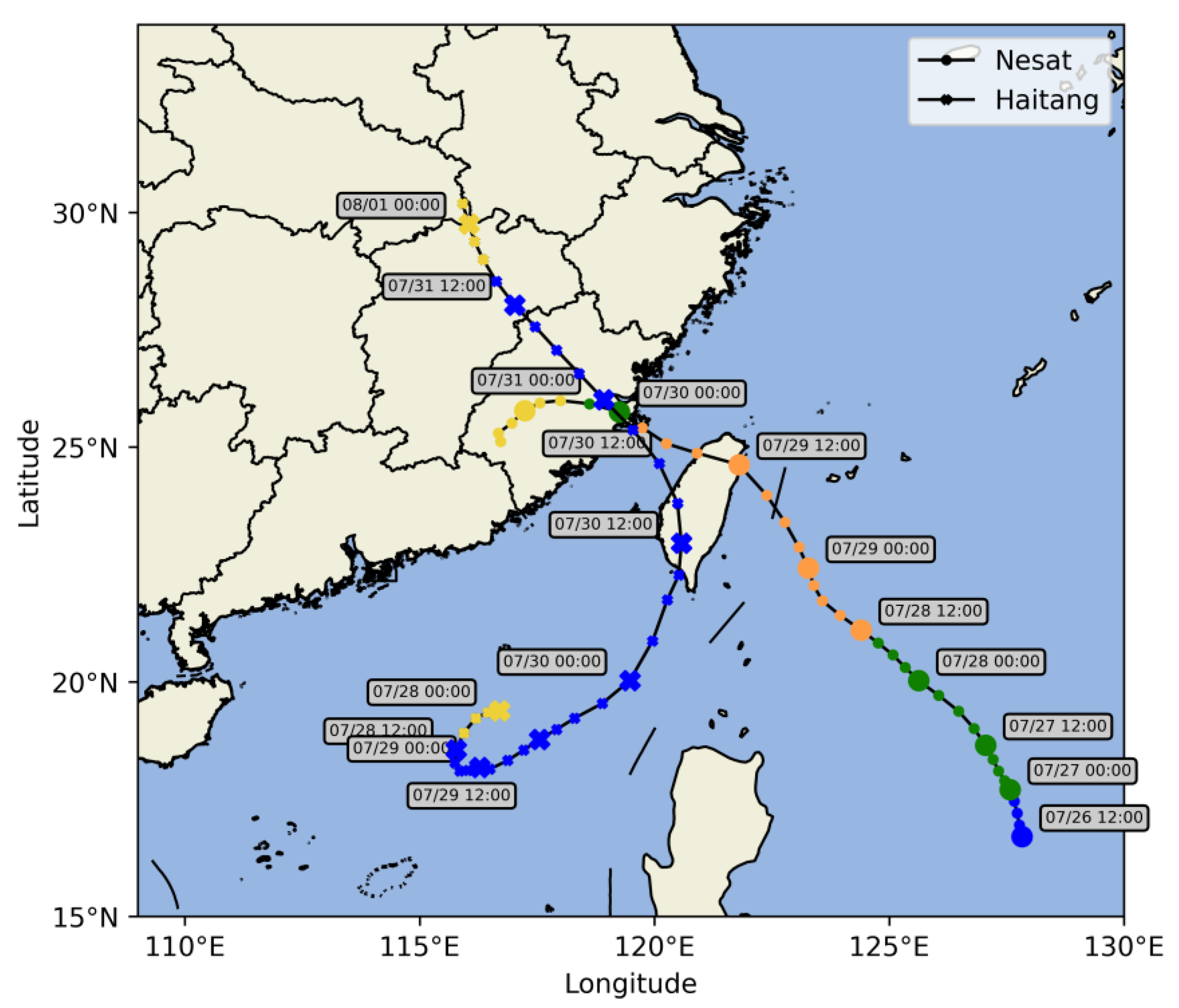
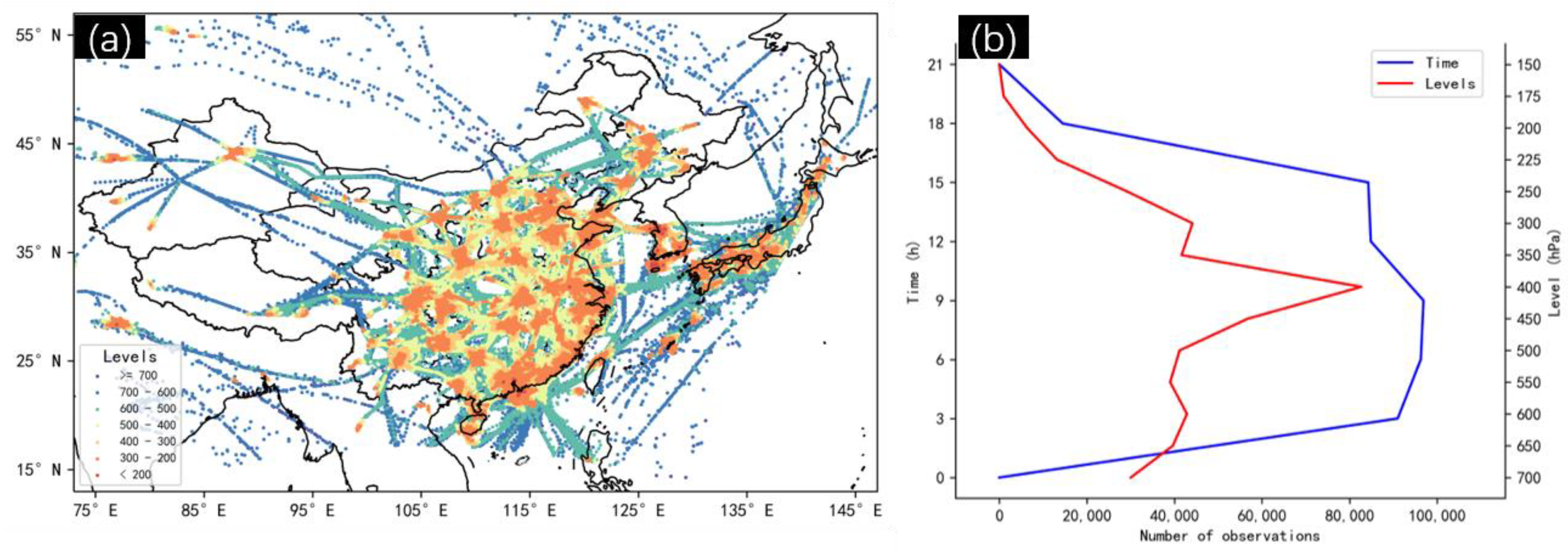

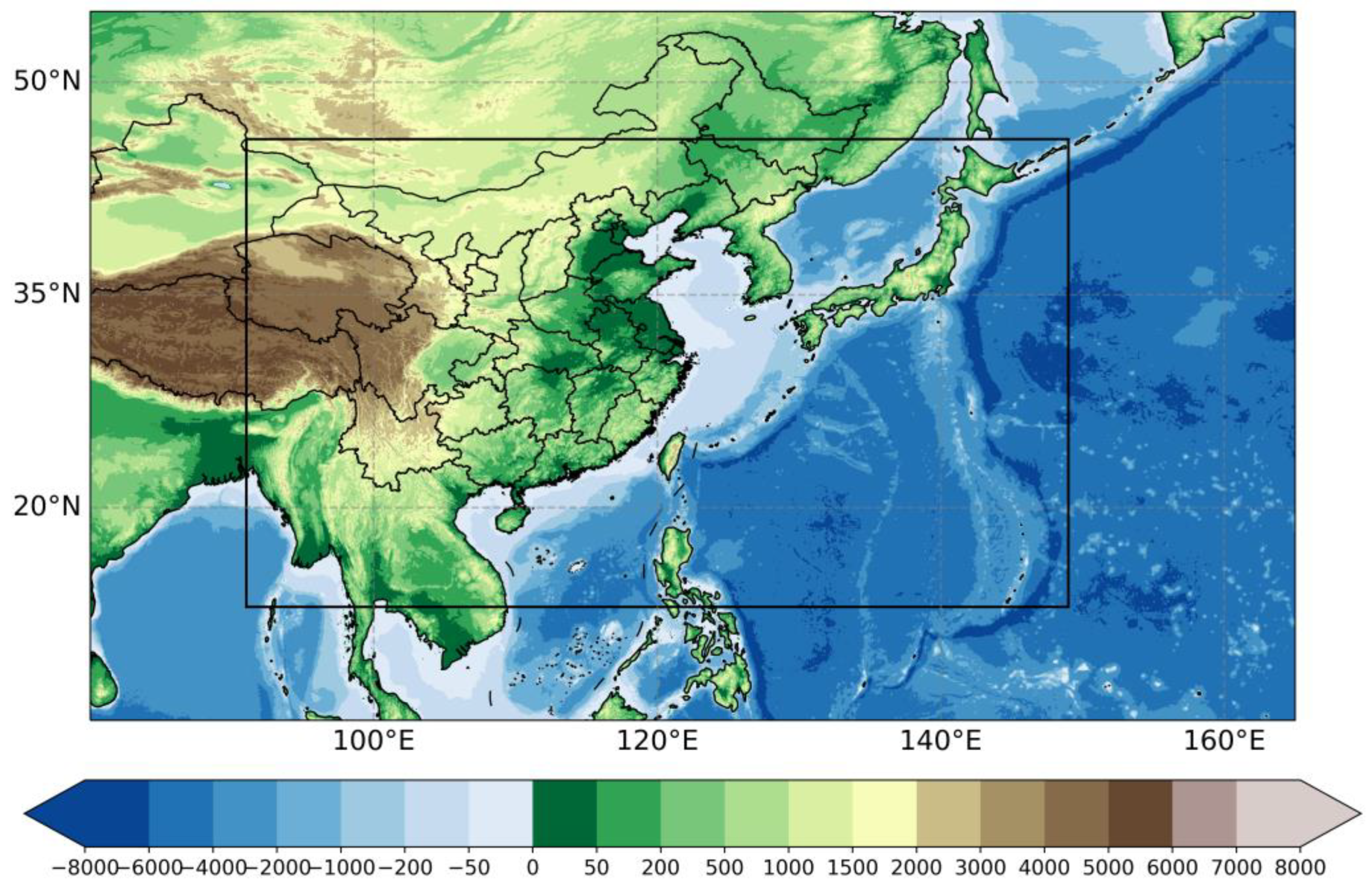
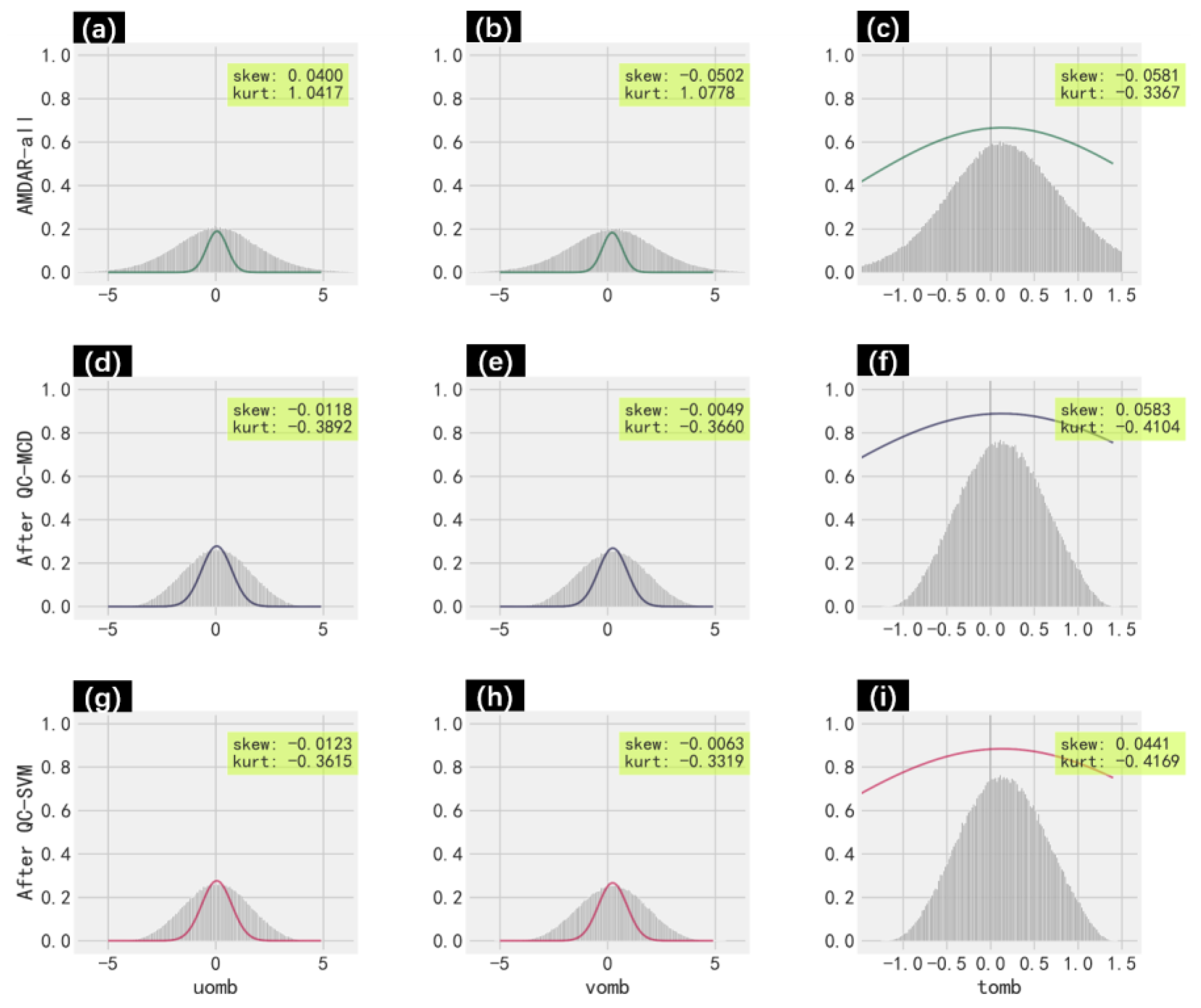

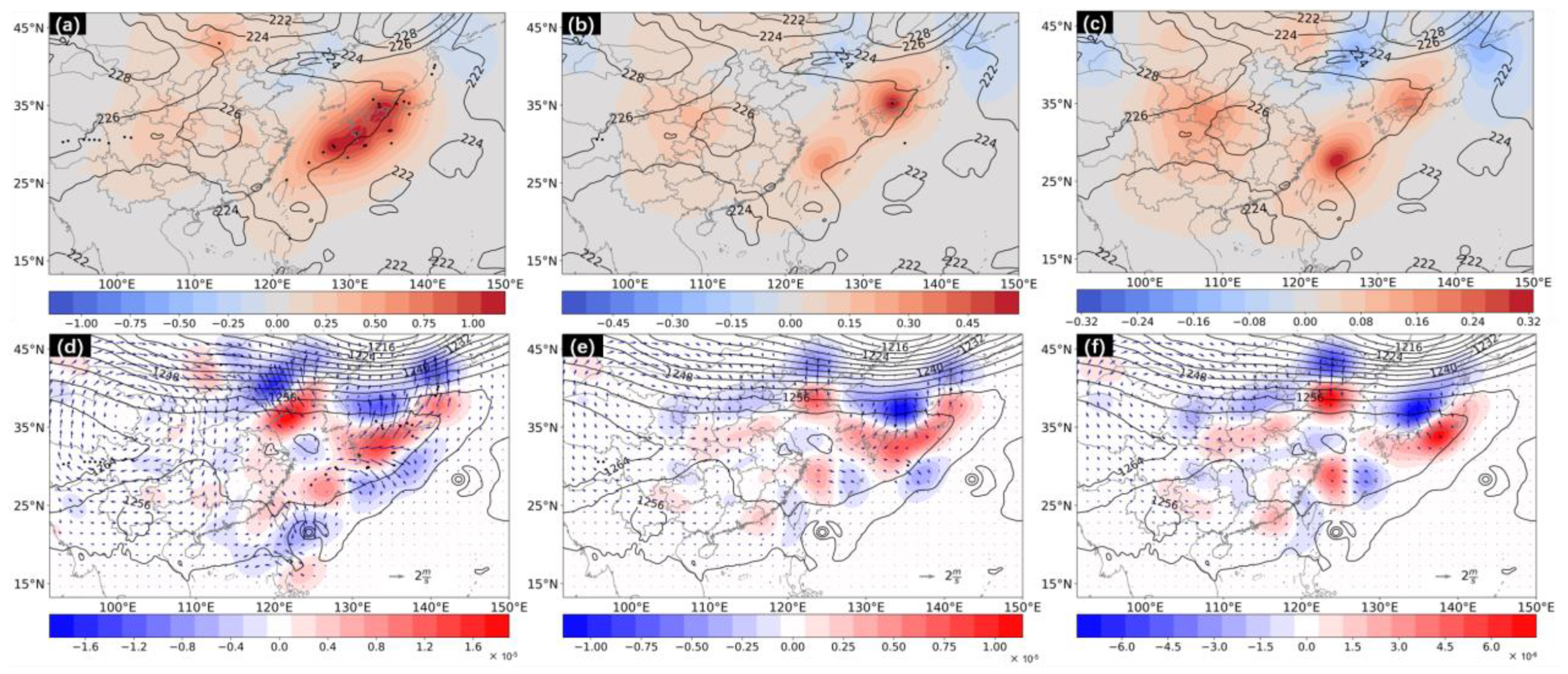



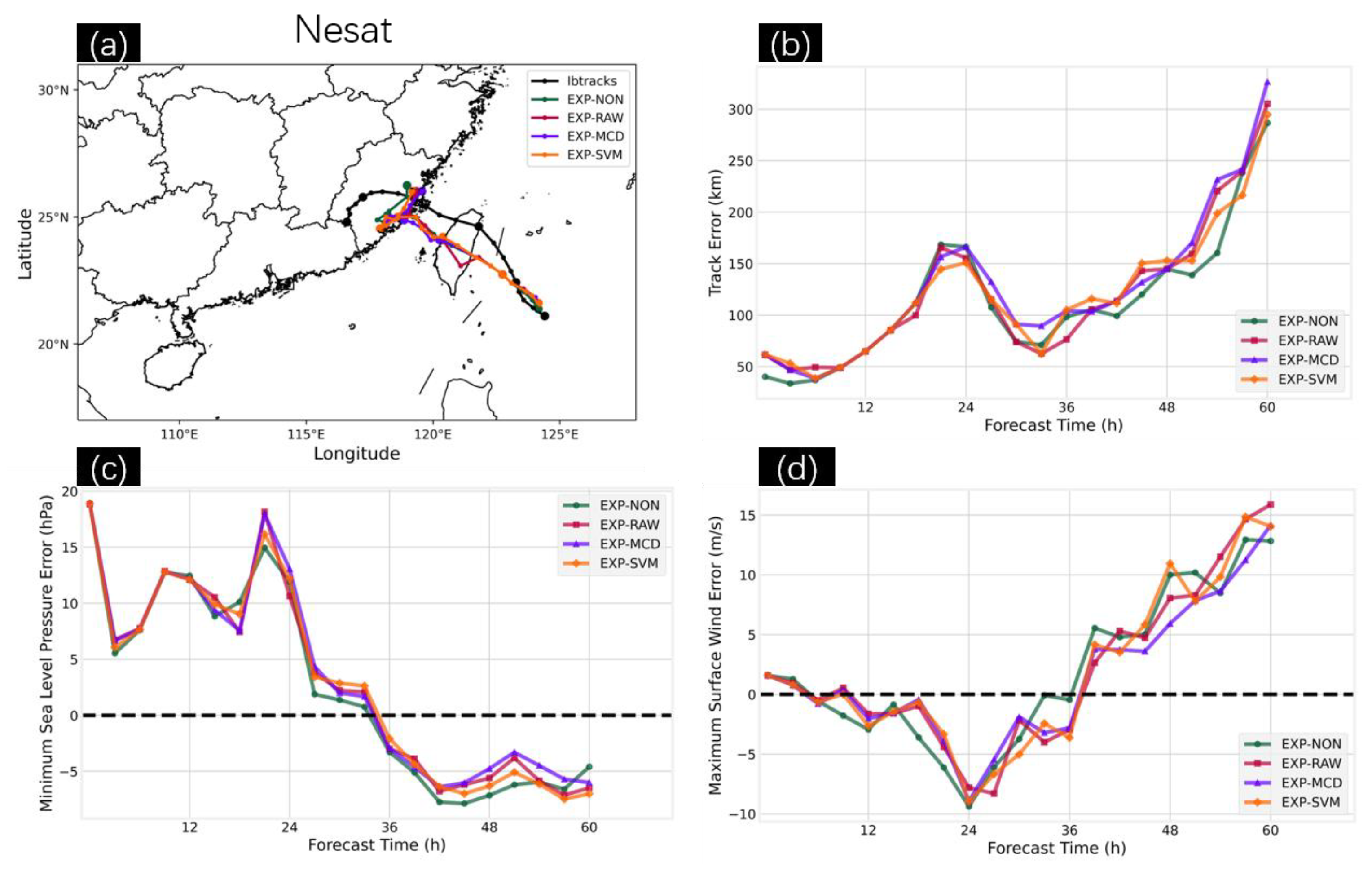

| Experiment | Description |
|---|---|
| EXP-CNTL | No data assimilation |
| EXP-RAW | Assimilating all the AMDAR data |
| EXP-MCD | Assimilating the AMDAR data after removing outliers identified by QC-MCD method |
| EXP-SVM | Assimilating the AMDAR data after removing outliers identified by OC-SVM method |
Disclaimer/Publisher’s Note: The statements, opinions and data contained in all publications are solely those of the individual author(s) and contributor(s) and not of MDPI and/or the editor(s). MDPI and/or the editor(s) disclaim responsibility for any injury to people or property resulting from any ideas, methods, instructions or products referred to in the content. |
© 2023 by the authors. Licensee MDPI, Basel, Switzerland. This article is an open access article distributed under the terms and conditions of the Creative Commons Attribution (CC BY) license (https://creativecommons.org/licenses/by/4.0/).
Share and Cite
Li, J.; Zhang, Y.; Chen, S.; Shao, D.; Hu, J.; Feng, J.; Tan, Q.; Wu, D.; Kang, J. Comparing Quality Control Procedures Based on Minimum Covariance Determinant and One-Class Support Vector Machine Methods of Aircraft Meteorological Data Relay Data Assimilation in a Binary Typhoon Forecasting Case. Atmosphere 2023, 14, 1341. https://doi.org/10.3390/atmos14091341
Li J, Zhang Y, Chen S, Shao D, Hu J, Feng J, Tan Q, Wu D, Kang J. Comparing Quality Control Procedures Based on Minimum Covariance Determinant and One-Class Support Vector Machine Methods of Aircraft Meteorological Data Relay Data Assimilation in a Binary Typhoon Forecasting Case. Atmosphere. 2023; 14(9):1341. https://doi.org/10.3390/atmos14091341
Chicago/Turabian StyleLi, Jiajing, Yu Zhang, Siqi Chen, Duanzhou Shao, Jiazheng Hu, Junjie Feng, Qichang Tan, Deping Wu, and Jiaqi Kang. 2023. "Comparing Quality Control Procedures Based on Minimum Covariance Determinant and One-Class Support Vector Machine Methods of Aircraft Meteorological Data Relay Data Assimilation in a Binary Typhoon Forecasting Case" Atmosphere 14, no. 9: 1341. https://doi.org/10.3390/atmos14091341
APA StyleLi, J., Zhang, Y., Chen, S., Shao, D., Hu, J., Feng, J., Tan, Q., Wu, D., & Kang, J. (2023). Comparing Quality Control Procedures Based on Minimum Covariance Determinant and One-Class Support Vector Machine Methods of Aircraft Meteorological Data Relay Data Assimilation in a Binary Typhoon Forecasting Case. Atmosphere, 14(9), 1341. https://doi.org/10.3390/atmos14091341





